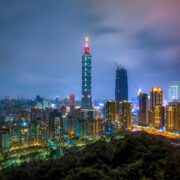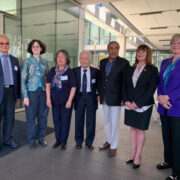The Early Life and Transformation of the San Diego Taiwan Center
Author: Cheng-yuan Huang
The San Diego Taiwan Center officially opened on February 28th, 1997, surpassing the expectations of many of the local Taiwanese community — you could even say that it was legendary. The San Diego Taiwanese community responded well to Chairman Chiu-shan Chen’s call to action, and all of the fundraising events for the Taiwan Center were extremely successful. The community members who promised donations fulfilled their promises quickly, and happily transferred funds to the Taiwan Center Foundation. It is said that kindness is contagious, which seems especially true in the case of the San Diego Taiwan Center. Participating in the fundraising for the Center gave community members an unprecedented sense of identity, and gradually we formed a sense of being one big “family,” united by our home country, Taiwan.
Since the Taiwan Center was to be our “home,” location was the number one priority for selecting the property (As they say, Location! Location! Location!). Naturally, we were extremely serious about carefully selecting a good location. In 1997, 99 Ranch Market supermarket chain had just begun opening locations in San Diego, and many enthusiastic directors of the Taiwan Center Foundation decided that finding a place within the neighborhood of 99 Ranch Market would be their top choice. We even considered renting the second floor of 99 Ranch Market, but ultimately decided against it because of the challenges posed by the price of rent and the high amount of traffic to the location. There were a number of warehouses and office buildings near 99 Ranch Market that we were continuously considering, but a number had to be eliminated from our search because of concerns about safety during Taiwan Center events. We continued to weigh our options, putting in more consideration than people put into choosing a wife or picking son-in-law. Finally, we decided on a location that had originally belonged to a church to become the very first home of the San Diego Taiwan Center.
In this area that measured 2,500 square feet, we began to weave the beautiful dream of having a Taiwan Center. The rent was about 65 cents per square foot, but we felt that as long as we had love in our hearts, it would be a wonderful place for us. Cheng-chiu Lai, an association member who acted as the real estate agent for the rental, kindly donated her commission as the funds for the kitchen renovation. The First Bank of San Diego, founded by community member Chun-hsiung Fang, donated a 50-inch TV. Thus, having a complete building equipped with a kitchen, a main hall, a conference room, and employee’s offices, the Taiwan Center started operations and began to grow. When it first opened, all the office equipment in the Taiwan Center was provided or sponsored by the association. Dr. Cheng-hsien Chen provided large conference tables, bookshelves, and chairs for the conference room. The seating for the main hall was purchased or sponsored by the association. The main hall piano was gifted by association member M. S. Wu. Many of the tables, chairs, benches, and other small necessities were donated by enthusiastic community members. The opening hours of the Taiwan Center were managed by the Taiwan Center Foundation and the volunteers who signed up to take on shifts.
At the time, the Taiwan Center was like a young man who had just entered society — not afraid of falling down or encountering difficulties. As long as there was this new home, the difficult things seemed a little simpler, and we were still filled with joy. Additionally, the warmth that the Taiwan Center brought to our lives infected all the community members who visited it. The only hired employee of the Taiwan Center was the full-time secretary, Ms. Yang Li-chu. Otherwise, the Center’s ability to smoothly operate was completely reliant on the selfless and uncompensated volunteer work of community members. The volunteer schedule was organized by Wu-hung Liu. It is hard to imagine how we would’ve kept the Taiwan Center open from 10 am to 8 pm Tuesday through Friday, and even longer on weekends, if not for the many volunteers that helped staff the Center.
Chairman Chiu-shan Chen and Taiwan Center Director, Dr. Fu-peng Pan treated the Taiwan Center like their own homes. During their lunch break or after work, they would visit the Taiwan Center on a short “business trip.” If Wu-hung Liu was unable to schedule anyone to work in the Center, Chairman Chiu-shan Chen would schedule himself for a shift. Since my schedule was rather flexible, I’d often go to the Taiwan Center to walk around a bit, and when I was there, I never missed the opportunity to see them. The general affairs and miscellaneous details of the Taiwan Center were managed by community member Yung-hsien Kuo, allowing the Center to save the price of paying for such maintenance work.
The activities of the Center were relatively fixed. Every month there would be a lifestyle lecture, where community members were invited to share their life or work experiences with each other. The rest of the activities at the Taiwan Center were centered around the Taiwanese Association of America’s activities. Generally speaking, the Center was more than big enough to serve the regular groups of visitors. It was only during the large-scale annual TAA meeting that had over 400 attendees, that the building would become very crowded and lively. Other Taiwanese organizations such as the tennis club, Taiwanese Chamber of Commerce, and the Formosan Association for Public Affairs also chose to hold their events in the Taiwan Center. Thus, the San Diego Taiwan Center slowly became known throughout San Diego and other parts of the US, and it became an important place where Taiwanese community members could get information.
In the beginning, since the Taiwan Center Foundation Board of Directors had just been established, it only had 9 members. In order to create a long-lasting system, the board charter required that one-third of the board be reelected every year. Therefore, the nine directors each had a different term length. In order to avoid the corruption problem that many organizations run into when their officers hold permanent office, we made it so that directors had a term limit. Additionally, an individual had to be out of office for at least a full year before they could be reelected to the board. The board also decided that the Taiwan Center Foundation would not accept, nor ask for financial assistance from the Taiwanese government. The Foundation is a non-profit, non-political organization that is registered with the IRS. Directors are not allowed to accept positions in the Taiwanese government, and overseas Taiwanese affairs consultants and commissioners may not serve as directors. The size of the board was not fixed but the number of board members was limited to between nine and fifteen directors. Since every organization has its own reelection process, in order to broaden the scope of participation, the heads of each organization were invited onto the board of directors to represent their various organizations. Thus, the Taiwan Center has been well-supervised by the Foundation, and its management has been very successful. The Foundation meets quarterly and publishes monthly reports about our activities and events in both Chinese and English.
Our Foundation’s Board of Directors is very serious about the management of Foundation affairs; each year our fundraising events meet the expected budget. President J. P. Lee of the Taiwan Chamber of Commerce, one of the first directors of the Foundation, pledged $100,000, rapidly increasing the funds being saved for the Taiwan Center’s permanent home. This kind of story is truly moving.
The activities offered at the Taiwan Center were increasing day by day. There were computer classes, tutoring for English and math, and summer programs for the youth. The professors for these courses were all experts and first-class doctorate-level association members. The subjects they offered were all the latest research in their fields, and they were using the best hardware, software, and equipment available at the time. The involvement of Fu-peng Pan and Chiu-fang Hsiao during that time truly leaves an impression.
During that time, the Taiwan Center’s library and special collections were just being established and were starting to archive information. Tsai-wei Huang and James J. Y. Hsu were the greatest contributors to these projects. Of course, today’s standards of computer software are very different from back then, and without today’s technology, these projects were quite difficult. We used the Library of Congress cataloging and filing method, which is also used by all the large universities across the nation. Ms. Tsai-wei Huang treated the library as her home, taking the thousands of books that poured into the Center and cataloguing them one-by-one and making records of them. Afterwards, she manually entered each book into the computer and filed them. I occasionally gave some guidance on the software, but the time and labor she invested into the project is unfathomable to those who have not experienced it themselves. The current computerized library system only came after the improved software programs were developed.
In regard to the fundraising events for the Taiwan Center, Ms. Hui-mei Wang was the number-one contributor. She conceived the idea of selling shopping vouchers for the local 99 Ranch Market as a way of raising funds for the Center. The vouchers gave back $5-10 for every $100 spent, and she donated all the profits to the Taiwan Center Foundation. Since our association members were very supportive of this fundraising method, Ms. Wang’s donation was $20,000 to $30,000 annually, which was enough to support many of the Center’s operating costs. More importantly, her contribution was like planting a seed, which inspired the enthusiastic participation of many other association members and gave the Taiwan Center more power as a uniting force. Through their actions, the association members displayed their support of the Taiwan Center.
At this stage in their life, the Foundation and the Taiwan Center had a number of unique characteristics: 1) The directors of the Foundation wholly dedicated themselves to the Taiwan Center and to serving their fellow community members. The Center’s operations were heavily reliant on the assistance of volunteers, which allowed the Taiwan Center to be built up from nothing, to be turned from an ideal into a reality, and to slowly create the early prototype of the Taiwan Center. 2) The Taiwan Center took the lead in offering scholarships to high schoolers in the San Diego area by offering scholarships to graduating seniors from all 58 high schools in the area. The Taiwan Center selected three outstanding students a year and awarded them $1,000 each, which was the highest scholarship a high schooler could receive at that time. The Taiwan Center Foundation immediately received a lot of attention from all the local high schools. 3) The Taiwan Center created the “Taiwan Award” at the annual San Diego Science and Engineering Fair, which was one of the four largest awards granted at the fair. 4) The Taiwan Center Foundation maintained an anti-political stance and refused subsidies from the Taiwanese government. Members of overseas Chinese affairs committees and consultants are not allowed to be involved in the Board of Directors or operations of the Taiwan Center.
The Taiwan Center continued to progress steadily and slowly developed year after year. As the number of Taiwanese community members participating in the Center’s activities continued to grow, the Center began to outgrow its location. Through ordinary methods, the Taiwan Center Foundation’s Board of Directors had silently achieved an extraordinary result. After the third year of the Taiwan Center’s establishment, we began looking for a bigger and better location that would be able to satisfy the needs of the Taiwanese community. Through the recommendation of Dr. Chiu-shan Chen, community member Chris Fan joined the Board of Directors and was elected as the chairman of the Foundation. New leadership and new policies brought a breath of fresh air to the Foundation. Chris Fan’s methods of operation were clearly different, and the Taiwan Center quickly began to transform. After a number of massive, earth-shattering events occurred in Taiwan, the Taiwan Center became the focus of American mainstream media overnight.
Dr. Fan Ching-ling is a successful entrepreneur in the biochemical technology industry who was recommended by Chairman Chiu-shan Chen to serve on the Board of Directors and serve as chairman. His first proposal was that the Taiwan Center needed a full-time director. Without any pay or benefits, Fu-peng Pan was essentially serving as a part-time, unpaid director, but he still had to manage the daily needs of the Center. The Taiwan Center decided to start hiring a full-time Center Director to manage these affairs. During this period, the directors also elected to have Shu Cheng Cheng and Edward Cheng join the Board of Directors, as they both had long-term experience in joint business ventures. Their addition made the operations of the Board of Directors more dynamic.
Under the hard work and guidance of Shu Cheng Cheng and Edward Cheng, the board strengthened its constitution, increased the maximum number of directors to 30, and changed the length of office from two years to three years. They also removed the requirement of one year out of office before reelection. All of these changes were made so that more people could directly participate in the operations of the Foundation and the Taiwan Center. Moreover, by assigning directors official titles, the responsibility for fundraising could be directly assigned to the directors of the Foundation. If each director could take on the responsibility of raising $3,000 (or $5,000) a year, then there would be a way to fund the Taiwan Center’s annual budget of over $100,000. Thus, the ability to raise funds became one of the many responsibilities of the Foundation’s directors.
Chris Fan enlisted association member Tsung-han Yang to work as the editor of the Center’s quarterly newsletter, and Ms. Ying-li Liu as the art director and consultant. Moreover, he began leading the board in planning for the permanent location of the Taiwan Center. Before we had determined the new location of the Center, we continued to lease the current building. On one hand, we continued to schedule various activities and make redecoration plans for the current location, successfully transforming it into a modern, large-scale business. On the other hand, we established a committee to find a new location, and when they successfully found a potential property, we asked an architect to draw up blueprints for a new Taiwan Center. Our beautiful dream of having our very own Taiwan Center was becoming more of a reality each coming day.
After Chris Fan had been serving as Chairman for quite some time and the Center’s activities became more focused on music, fine arts, and cultural activities, the Taiwan Center became solidified as a very unique and structured organization in the minds of the local Taiwanese community and in the eyes of the American public. Many local government offices, private organizations, and media outlets in San Diego established positive and friendly attitudes towards the Taiwan Center. This has had a long-term impact on the development of the Taiwan Center, the search for a permanent location, and the negotiation of many of our events. Moreover, the Taiwan Center has gradually become a very important source of information about Taiwan.
After having some experience, the Taiwanese Association of American and the Taiwan Center began to seriously consider and actively promote the creation of care teams and activities. We continued to attend the Taiwan Center’s events, participating in the weekly senior citizens activities. Each week we would choose a suitable song and prepare to sing it together. Then, using the midday lunch break, we would go to the Taiwan Center participate in singing activities. We continued to do this for three or four years, until I went to South Africa to purify my mind and Shu-ling was left to lead these activities alone. Only after 2001 was calm finally restored in our lives.
By this point, the Taiwan Center had established very good operating system. The Taiwan Center has organized a number of activities and classes which were quite popular among the association members and students. The summer youth programs were especially popular, since they were very complete and carefully planned. They used to be long-anticipated by families with children, and these programs were also ideal for older students looking for summer work or community service opportunities. It is a pity that these programs did not continue and have become a thing of the past. Even more unfortunate is that while the Taiwan Center provided equipment to churches and the Taiwanese Association to use, the use of the Taiwan Center itself remained low and had much room for improvement. I had the opportunity to invite a famous test prep company to offer an SAT and PSAT test prep class which could be regularly held at the Taiwan Center. On one hand, it would bring the Taiwan Center some income, and on the other hand, it might increase the Center’s popularity among the general public. Unfortunately, the Taiwan Center had different options to consider, so the Board of Directors did not approve my proposal.
Of course, throughout this entire period there were a number of huge, earth-shaking events that changed everything. On September 21st, 1999, I was driving on Interstate 8 on the way to school to prepare for my one o’clock class at around 12:50 when I heard on the radio that a large earthquake with a magnitude of 7.2 had just happened in Taiwan. It was exactly 3:47 in the morning in Taiwan, and the news reporter said that a number of landslides had occurred, and many buildings collapsed, so it was likely that there would be a lot of casualties. My heart was beating quickly, and I was terrified. It was a Monday, the one day a week when the Taiwan Center was closed for business. All of San Diego’s broadcasting stations went to the Taiwan Center, but they could only get a short interview from Chris Fan. I immediately told Chairman Chris Fan that this earthquake might not be the same as those of the past; Taiwan’s accumulated experience from previous earthquakes might not be enough to help Taiwan face this present disaster. Chairman Chris Fan immediately took my words to heart and changed his attitude. He began getting the Taiwan Center ready to take action and lead. Chairman Fan used his influence and communication skills to their full potential. In the two short months starting from the day of the earthquake running through November, the Taiwan Center was able to become the best platform for earthquake relief fundraising and a number of public relations negotiations. It seemed as though in an instant the San Diego Taiwan Center had become the commander-in-chief of all the overseas Taiwanese. Taiwan Centers across the country had already had a few experiences coordinating with one another to host Taiwan Heritage Week, but this time they we integrated together even more quickly. While San Diego may not be the city with the largest Taiwanese population, under the guidance of Chairman Fan, the 921 earthquake fundraiser was able to raise nearly half a million dollars. The Foundation board also had plans to send funds to directly give relief aid to needy mountain villages in Taiwan.
This earthquake changed Taiwanese society, politics, and people’s characters, altering Taiwan’s attitude just at the turn of the century. On March 20th, 2000, the night before the Taiwanese presidential election, the Taiwan Center stayed open all night. At the same time that Taiwan’s broadcasting stations were announcing the results of the election, the Taiwan Center was enthusiastically celebrating the transformation of Taiwan’s political scene. A quiet but happy democratic revolution had just successfully taken place in Taiwan.
A year passed, and then suddenly the September 11th terrorist attacks in New York City shocked the nation. Civilian aircrafts had been hijacked and used as weapons to attack the World Trade Center and the Pentagon, symbols of the United States. This incident changed the daily life of Americans and altered American society. The most obvious change was the American populace began to move to medium-sized cities. San Diego naturally became a popular choice, and the number of Taiwanese Americans who moved to San Diego rapidly increased. The staff and services of the Taiwan Center began to slowly adjust too. As we saw many new faces participating in its events, we also began to witness the growth of the Taiwan Center. This represents the growth and resilience of the Taiwan Center and is a perfect example of institutional evolution. I sincerely believe that the Taiwan Center’s continued development is something that we can expect and something that will be successful.
At this stage in its life, the Taiwan Center had several important characteristics: 1) the number of Foundation members increased, the size of the Foundation Board of Directors increased to 30, and the term of office was extended from two years to three years. 2) The activities of the center focused on music, literature, and the arts, and surpassed the types of performances traditionally offered by the Taiwanese Association. These cultural activities gave the Taiwan Center a positive public image and helped transform its role in the community. 3) The Board of Directors was actively planning to move to a permanent location and was working hard to promote it. Unfortunately, they lacked the necessary momentum, and it was regretfully unsuccessful. 4) The Center successfully organized a number of activities, including Senior Citizen groups, dance classes, language classes, and more. These activities established the Center’s uniqueness and helped the Taiwan Center broaden its scope of service. 5) Due to social and political changes occurring in Taiwan and the US over this period of time, the Taiwan Center took on an active leadership role. The Center expressed its love for the Taiwanese community through excellent its fundraising efforts, which also put the Taiwan Center in the spotlight of San Diego’s media coverage. The Taiwan Center is a very precious asset to the Taiwanese community, and I look forward to all of the community members who will continue to love Taiwan and to keep striving to maintain and cherish the Taiwan Center.
Source: Cheng-yuan Huang
Translated from 26. 聖地牙哥台灣中心的前半生與轉型/黃正源/2014/09





